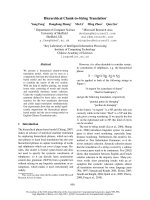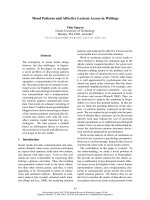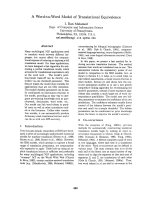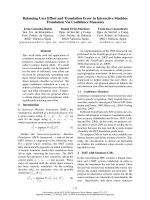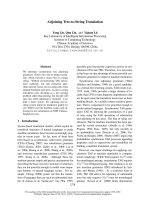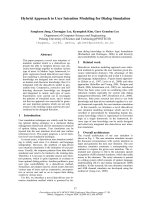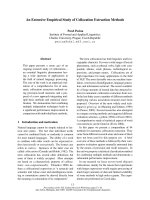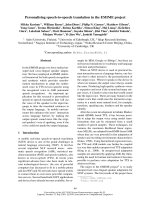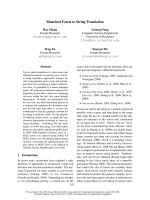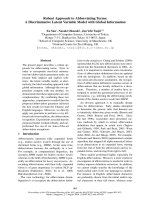Báo cáo khoa học: "AN APPROACH TO SENTENCE-LEVEL TRANSLATION ANAPHORA IN MACHINE" ppt
Bạn đang xem bản rút gọn của tài liệu. Xem và tải ngay bản đầy đủ của tài liệu tại đây (778.09 KB, 9 trang )
AN APPROACH TO SENTENCE-LEVEL ANAPHORA IN MACHINE
TRANSLATION
Gertjan van Noord, Joke Dorrepaal, Doug Arnold
Steven Krauwer, Louisa Sadler, Louis des Tombe
Foundation of Language Technology
State University of Utrecht
Trans 10 3512 JK Utrecht
Dept of Language and Linguistics
University of Essex, Wivenhoe Park,
Colchester, C04 3SQ, UK.
February 15, 1989
Abstract
Theoretical research in the area of machine translation usu-
ally involves the search for and creation of an appropriate
formalism. An important issue in this respect is the way in
which the compositionality of translation is to be defined.
In this paper, we will introduce the anaphoric component
of the Mimo formalism. It makes the definition and trans-
lation of anaphoric relations possible, relations which are
usually problematic for systems that adhere to strict com-
positionality. In iVlimo, the translation of anaphoric rela-
tions is compositional. The anaphoric component is used
to define linguistic phenomena such as wh-movement, the
passive and the binding of reflexives and pronouns mono-
lingually. The actual working of the component will be
shown in this paper by means of a detailed discussion of
wh-movement.
Introduction
Theoretical research as part of machine translation often
aims at finding an appropriate formalism. One of the main
issues involved is whether the formalism does full justice
to the idea that the translation of a whole is built from
the translation of its parts on the one hand and whether
it leaves enough room for the treatment of exceptions on
the other hand. In other words, the question is in what
way the idea of compositionality is to be defined within
a particular formalism. An answer to this question from
an interlingual perspective is given in the literature on the
Rosetta system (e.g. Landsbergen 1985). The CAT frame-
work (e.g. Arnold et a]. 1986) was meant to be an an-
swer to the same question, this time for a transfer system,
viz. the Eurotra system. The MiMo formalism is a re-
action to the CAT framework and tries to solve several
translation problems by formulating an alternative defini-
tion of compositionality. Phenomena involving anaphora
I such as wh-movement and the coindexation of pronomi-
nais often cause problems for strictly compositional systems
since translation of one word depends
on (the
translation
of) another word, one which can be quite far away in the
sentence. Rosetta tackles this problem by distinguishing
between rules that are significant with respect to the com-
posRionality of translation, so-called meaningful rules, and
rules that are not, referred to as transformations (Appelo
et al. 1987); in this way the system is not compositional in
the strict sense anymore. The notion of compositlonaUty
MiMo adheres to is defined in such a way that anaphoric
relations can be translated compositionally as well. In this
paper we wiLi introduce the anaphoric component of the
MiMo formalism. It is used to define Linguistic phenomena
such as wh-movement, the binding of reflexives and pro-
nouns, the passive and control phenomena monolinguaLiy.
The formalism will be discussed by means of an extensive
description of a possible analysis of wh-movement.
In the next section, we will first discuss and motivate some
of the more fundamental characteristics of the MiMo trans-
lation system. Section two will sketch the MiMo formalism
1In thls paper the term 'ansphori¢' should be interpreted in the
broaclest lense, as opposed to Chomsky 1981 in which only A-traces
and reflexives are called anaphoric.
- 299-
as far as necessary for understanding what will follow. The
component that deais with the treatment of anaphora will
be discussed in section 3. In the fourth section the ac-
tual working of the component will be shown by an elab-
orate discussion of wh-movement. Finaily, the translation
of anaphoric relations will be defined and some idea will
be given of the kind of problems that remain and that will
have to be subject to further research.
1 MiMo
The MiMo formalism tries to come up with an answer to
the question what compositional translation should imply.
Strictly compositional systems have to deal with several
translation problems. As to what these problems exactly
are depends on the nature of the definition of the notion
compositionality. In general, two kinds of problems can
be distinguished. First, there are the problems that arise
when languages do not really match. Second, the problems
that occur when translations of two constructions depend
on one another.
The former type of problem is caused by lexical and struc-
tural holes. It means that source and target representation
do not really match. Lexical holes occur when a language
lacks words equivalent to the ones in the source language.
In the case of structural holes, the target language lacks
an equivalent construction rather than a word. A descrip-
tion of the concept will have to be used in these cases. For
an example of a lexical hole, compare sentence (1) and its
translation into English (2).
(1) Jan zwemt graag
(2) John likes to swim
Unlike sentences with an adverb like 'vandaag', (i) cannot
be translated c0mpositionally in the strictest sense. The
translation of (1) is not simply the translation of the parts
the constituent is composed of. This problem has been
solved in the CAT framework by liberalizing the definition
of compositionaiity in such a way that it will be possible to
render (1) directly into (2), by means of a rule like (3).
(4) Jan zwom ge,oonlijk
John used to
swim
(5) Jan zwom
gewoonlijk graag
John used to like to swim
The translation of 'gewoonlijk' requires a rule similar to
(3). However, a combination of 'graag' and 'gewoonlijk'
appears to be possible as well. An additional rule will have
to account for this. This will lead to an enormous explosion
of the number of rules. It is one of the main reasons for an
alternative definition of compositionality within the MiMo
system. The nature of the definition allows the translation
of both 'gewoonlijk' and 'graag' in case they cooccur. A
translation rule separates a constituent into an ordinary
part and an exceptional part. Both parts are then trans-
lated separately and finally, in the target language, the two
translated parts are joined again. In the case of a sentence
consisting of both 'graag' and 'gewoonUjk', the sentence
is separated into an exceptional part, 'graag' for example,
and an ordinary part, the rest of the sentence. This rest
again is separated into an exceptional, 'gewoonlijk', and an
ordinary part. The latter is again that which is left be-
hind after extraction of the exceptional part. In the end,
all these parts are joined and will make up a construction
in the target language. So, in MiMo not all daughters are
translated in one shot but part of a constituent is translated
while the rules can still work on the rest of the constituent.
An extensive discussion ofproblerns like these is to be found
in Arnold e.a (1988).
The second type of problems w.r.t compositionality in
translation involves translation of phrases that are mutu-
ally dependent. Examples hereof are translations of phrases
that are anaphorically linked. Translation requires that
these relations are established. Examples are to be found
in (8). In (6), the relation between the subject and the re-
fiexive pronominal is necessary to arrive at the correct form
of the reflexive pronominal in French. In (7), knowledge of
the functional status of the wh-word is relevant to be able
to generate the right case in German.
(6) the women think of themselves =~
les femmes pensent a elles-memes/*ils-memes
(7) who did you see =~ wen/*wer/*wem sahest du
(3) rl(sl,s2,graag) ==~ r2(t(sl),r3(like,t(s2)))
By (3) a construction composed of three daughters, sl, s2
and 'graag' will be translated into a construction having
two daughters, viz. the translation of sl and a construc-
tion that again has two daughters, that is, the verb 'like'
and the translation of s2. The main disadvantage of this
approach is the fact that combinations of exceptions have
to be described explicitly again, see (4) and (5).
In this paper we will examine the component of the MiMo
formalism that has been developed to enable the formula.
tion of anaphoric relations on the one hand and composi-
tional translation on .the other. The system distinguishes
itself from other systems in the field of computational lin-
guistics, such as GPSG (Gazdar et al. 1985), PATR (see
e.g. Shieber 1986) and DCG (Pereira and Warren 1980)
for its central notion of modularity. The formalism enables
- 300 -
the writer of rules to express generalizations in a simple
and declarative way. This will be exemplified in section
4. In an MT context, it is however not enough to es-
tablish anaphoric relations monolingually. The question
is what the behaviour of these relations in translation is.
In MiMo, it is possible to translate the relations composi-
tionally. This will be discussed in section 5.
2 The basic model
In this section an overview of the MiMo system will be given
as far as is relevant for the rest of this paper. The system's
architecture is as in (8). In (8) it is indicated that a text in
(8) source text
l analyse
source-I
[
transfer
target-I
[ synthese
target text
a source language is parsed into an interface structure (I).
This I-structure, in its turn, is translated into an interface
structure in the target language. From this structure the
target language text can then be generated. In this paper,
mainly the construction of I-structures, through analysis
and through transfer, will be focused on, hence the impor-
tance of understanding what these structures look like in
MiMo terms.
An I-structure is a tree. The mother node consists of the
lexical identifier (LI, the name of the lexical element), possi-
bly provided with a set of features, and a number of slots.
Slots can be filled with other I-structures that meet the
requirements specified by the slots. (9) is an example of
an I-structure. The I-structure (9) has an LI 'kiss' and two
(9) kiss(verb)
(10)
kiss(verb)
/ \ .[subjfjohn(n),
subj(n) obj(n) obj=mary(n)]
I I
john(n) mary(n)
slots, an object slot and a subject slot. Fillers of these slots
will have to be nominal. The subject slot has been filled by
an I-structure that has 'john' as LI, the object slot by the
I-structure with LI 'mary'. We will abbreviate structures
like these as in (10) henceforth. So, an I-structure consists
of a certain LI, a feature bundle in parenthesis and a num-
ber of slots in square brackets preceded by a dot. A slot
is made up of the name followed by the equal sign and
the
I-structure that fills it.
Possible I-structures are defined in the lexicon. Distinct
(phrase structure) rules that define I-structures are not
needed, all structures are specified in the lexicon. Gen-
eralizations should be expressed in the lexicon as well. The
advantage of this approach is the possibility of defining all
subcategorization phenomena directly. So, only coherent
structures in the sense of LFG (Bresnan 1982) are built.
In the lexicon, the slots have not yet been filled by other
I-structures. The I-structure for 'kiss' looks like (11) in
the
lexicon, the question marks indicate that the slot are still
empty. In (12) the lexical representation of 'john' is given,
which has no slots. When an I-structure can fill the slot of
(11)
kiss(v)
(12)
john(n).[]
.[subj
= ?(n),
obj = ?(n) 3
some other I-structure, the features of the slot and those
of the I-structure are unified (see e.g. Shieber 1987). The
I-structures represented so far were simplified for the sake
of readability. In reality, there is the possibility of indicat-
ing whether slots are optional or obligatory. Slots can also
be marked with the Kleene star. The effect of this opera-
tor is that the slot is copied when an I-structure fills the
slot. The I-structure will fill the copy and the original slot
remains as it was. The slot can he filled several times by
I-structures in this way. The slot for modmers is in fact
marked with the Kleene star 2 . An I-structure for (13a)
looks like (13b) s .
(13) a. De mooie vrouw ontmoet mannen op zondag
The nice woman
meets men
on sunday
b. ontmost(v,present)
.[subj = vrouw(n,definite)
.[mod = mooi(adj). D,
*mod = ?()],
obj = man(n,plural)
.[*mod = ?()S,
mod = op(prep)
.[obj = zondag(n),
*mod =
?()]
*mod =
?()]
Some words in the lexicon can have the special feature
2Thls results in a flat structure for modJ~ers, This is perhaps
not
correct from a linguistic
point of
view. However, translation ;-
often
much slmp]er this way. The representation of modifiers is s field in
MT that deserves further attention.
SNote that the order of slots is quite arbitrary. Surface order is
not reI~ted to the
order of slots in l-structures in any way.
- 301 -
'anaphor'. I-structures having this feature will have to be
bound by an antecedent in the end. Examples of these are
pronouns and reflexives. This requirement also holds for
empty slots. They are considered anaphoric and will have
to be bound as well unless we deal with optional slots.
Binding of I-structures happens through anaphoric rules.
In the next section we will show the way these rules are
formulated. The final structure of (13a) will be (14). In
(14), a relation between the topic (Ii) and the embedded
subject position (I2) 4 is established s . The subordinate
(14)
dat(comp)
.[spec = vroug(n,definite,I1)
.[ mod = mooi(adj). D],
compl = ontmoet(v,present)
.[subj
=
?(n,I2),
obj =
man(n,plural).[],
mod = op(p)
.[obj = zondag(n).D]]],
{ topic_trace(I1,I2)}
complementizer is also regarded as a lexical word. Even
sentences that do not show a complernentizer at surface
are assigned one. This is not in any way intrinsic to MiMo
but makes a uniform account of several phenomena possi-
ble. This type of cornplementizer has two slots: an optional
slot for topics or wh-words and a slot for a verb construc-
tion.
3
The definition of anaphoric rela-
tions
Anaphoric relations are defined by a type of rule that is
quite different from the ordinary rules. This distinguishes
the system from, for example DCG. With PATR and DCG
the possibility of percolation from, say topic to trace, influ-
ences all the other rules. MiMo's approach, a separate type
of rule for the anaphoric component, has the advantage of
leaving the other rules, i.e the lexical I-structures, as they
are. Modularity is one of MiMo's qualities. This quality is
also considered important in GPSG (Gasdar et al. 1985)
where it is realized by the use of metarules that multiply
the number of rules. This would be undesirable in MiMo
411 and I2 are unique nantes which are autonmtlcally assigned
to
every I-structure. We will indicate them henceforth as capitalized
words. Names to which no further reference is nmde will be omitted
for clarlty's sake. An I-structure consists of a tree and 8 set of anno-
tstlons that denote the anaphoric relations within the tree. The tree
annotated with this set will be called I-object henceforth.
6Note that we will usually leave out optional slots thet are
not
KUed
since every lexical word is its own rule. So then even the
number of words would have to be multiplied.
The use of a different rule type is also motivated by the
process of translating anaphoric relations. If we only used
feature percolation to encode anaphoric relations, the rela-
tions established would not be explicit anymore. Annota-
tions in MiMo are clearly distinguishable from the rest of
the representation and as such make it possible to define a
compositional translation of them in transfer.
Besides being modular, the system also proves to be declar-
ative. Both qualities, modularity and declarativity, en-
hance the workability for the user. Changes and exten-
sions are quite easily achieved and rules can be defined in
a general way. An anaphoric component written for one
particular language can often be used for another language
with minor changes.
Anaphoric rules create anaphoric relations within I-
structures. This has two consequences in our system. In the
first place, some of the features of antecedent and anaphor
are unified. These features are called 'transparent'. This,
for example, makes it possible to define agreement phenom-
ena. The linguist defines which features are transparent
with respect to a certain rule. The motivation for this ap-
proach is discussed at length in Krauwer et al. (1987). The
main point is that identity of some but not all features is
required in an antecedent-anaphor relation. In the second
place, the I-structure is augmented with an annotation that
specifies the binding. This annotation consists of the name
of the relation and the unique names of the nodes between
which the relation exists. The definition of anaphoric re-
lations makes use of these annotations (see also section 5).
A relation cannot be created unless the correct structural
relation between antecedent and anaphor exists. So the
grammar writer defines for each relation:
1) the name of the relation
2) the transparent features
3) the structural relation
An example of an anaphoric rule is the one that estab-
lishes a relation between a wh-element and an open slot.
The rule looks like (15) e MiMo 7 .
(15) wh_trace : c_command( {wh}, {open}
)-
{agreement,case}
The wh-trace relation is established when the structural
relation c_cornnmnd holds between a wh-constituent and
eIn f~ct, the wh-trace rel~tlon is subject to more restrlct;ons than
c-commandment. We will return to this in section 4.
7A special feature 'open' is used to refer
to open
slots. All slots
have this feature by default as long ~" they are not filled. Sot 'open'
can be regarded as a feature of the trace ~;nce slots
not (yet)
FtUed
can
he considered potential traces.
- 302-
an open slot• The agreement features and the case fea-
ture are unified if possible, if not, the relation will not be
established. The structural relation itself, c_command in
this case, is defined by the user as well. Either a simple
structural relation is defined or a complex structural rela-
tion. The latter is composed of a regular expression over
structural relations s . An example of a simple structural
relation is the sister-relation, defined in (16).
(16) sister(ANT,ANA) : (17) c_command:
?() .[ ? : ?(ANT), sister +
? = ?(ANA) ]
ancestor
The structural relation sister holds between the Lstructures
ANT and ANA if there exists an I-structure in which both
ANT and ANA fill slots• The exact nature of the LIs is
not important nor are the features or the names of the
slots, hence their representation as question marks in (16) 9
• A complex structural relation is defined by means of a
regular expression over structural relations. The regular
expressions make use of the operators '^', indicating op-
tionality, ';' for disjunction, '*' for iterativity (0, 1 or more
times ) and '+'. The latter has a special meaning which
can best be explained by means of the definition of the
c_command relation mentioned in (17). The '+' operator
indicates that the sister relation should hold between the
antecedent and some intermediate node and the ancestor-
relation between this intermediate node and the anaphor.
The Prolog-variant of (17) is (18)• So, the c_command re-
lation holds between the I-structures ANT and ANA when
one of ANT's sisters is ANA's ancestor. The MiMo defini-
(18)
c_command(Ant,Ana) :-
sister(Ant,X), ancestor(X,Ana).
tion of 'ancestor' is given in (19a). The relation is defined in
terms of the simple relation 'mother'. The structural rela-
tion of the latter is in (19b) 1° . Features can be added to the
structural pattern to restrict the range of possible relations
further. This will be illustrated in the fourth section when
we discuss a possible way of treating wh-movement. To
aThls idea il partly based on LFG's notion of functional uncer-
tainty. See Kaplan et al. 1987.
°Note
that the order of ANT w.r.t ANA is not relevant since the
order of the slots is not in any way related
to word
order in the
sentence.
l°All I-structures are also their own ancestor according to the deft-
nlt|onin (19a). This is the correct result when used in the c_command
deKnltlon since sisters do c_command one another. In case this is uno
desirable however, the relation could be defined as follows :
ancestor : mother + * mother
Generally, the correct deKrdtlon of a relation llke c.command depends
of course on the use it's being made of in anaphorlc rules and on the
make up of the I-structures used. The definition above should merely
be regarded as an exemplification of the mechanism.
(19) a. ancestor : * mother
b. mother(ANT,ANA) :
?(ANT).[ ? = ?(ANA)
conclude this section, we give an example of an Lstructure
to which (15) applies. (20b) shows the structure before and
(20c) after application of (15).
(20) a. war ziet John (what does John see)
b• dat (comp)
• [spec = war (wh).
[],
compl = zien(v)
• [subj = john(n,third,sing,masc),
obj = ?(open,ace)i]
c. dat (comp)
• [spec :
wat(wh,acc,I1).[],
compl = zien(v)
• [subj = john(n,third,sing,masc,I2) ,
obj = ?(open,acc,I3)]],
{.h_trace(I1, I3}
4 WH-Movement
In this section, the actual working of the anaphoric compo-
nent will be discussed. We will do this by showing how a
linguistic phenomenon like wh-movement could be imple-
mented. Note that none of the linguistics in this section
follows from the system. The aim of the discussion is to
give an idea of the power of the anaphoric component and of
the kinds of linguistics that can be put to use. We will first
introduce the linguistic environment and present some data
from Spanish that reflect some of the surface phenomena
caused by the presence of anaphoric relations. The section
on the implementation of the wh-relation will argue that
and show how surface phenomena of this nature can be
handled deterministically.
4.1 Introduction
The wh-trace relation seems the most interesting one be-
cause it shows both how general and powerful the mecha-
nism is and how restrictive the rules should be to account
for the data• At least the data shown in (21) should be
accounted for. In the GB framework (e.g. Chomsky 1981),
wh-movement is seen as an instance of the transformation
'move alpha', which respects the subjacency principle. The
- 303 -
(21) a. why do you think John left (ambiguous)
b. who do you think Bill told me Susan
said _ was ill (unbounded dependency)
c. *who do you believe the claim that Bill
saw _ (violation complex NP constraint)
d. *who do you know whether _ left
(violation wh-island constraint)
e. *who did you whisper _ came
(non-bridge verb)
(25) a.
b.
C.hC Co C t
S J S S ~ •
I I
[.h C [o C
t
S ~ S S ~ 8
I
II
I
of complementisers.
subjacency principle claims that no rule can relate X and
Y in the following structure (22):
(22) X E E.Y ] ]
a b where
a,
b bounding nodes
(23) who [
[t [Bill told
me
[t [Susan saw t
I s lls lls I
I II II I
For English, S and NP are assumed to be bounding nodes.
Wh-movement takes place cyclically via the comp-posltions
of the intermediate clauses, leaving behind traces (the so-
called comp-to-comp movement). As such, it does not cross
more than one bounding node at a time in a structure like
(23).
Our discussion of wh-movement in the next section is in
accordance with the comp-to-comp movement. Although
other approaches, such as direct movement, are feasible too,
we win adhere to the comp-to-comp approach. Data from
Spanish (Torrego 1984) also seem to support the preference
for actual movement from complementizer to complemen-
tizer.
(24) Que [ dice Juan [ que [ creian los dos [ que [ habia
pensado Pedro [ que [ habia aplazado el grupo [ el grupo
habia aplasado
What says John that thought the two that believed Peter
had postponed the group ; that the group had postponed
According to Torrego, inversion is obligatory in all clauses
except the lowest. In the lowest clause, inversion is op-
tional. The GB theory accounts for this by claiming that
for Spanish S-bar, instead of S, is the bounding node. This
predicts that movement in the lowest cycle can take place
in two ways, as shown in (25). Neither of the two violates
subjacency. Assuming that a wh-constituent, or its trace,
in comp triggers inversion, the variation in Spanish word-
order in the lowest cycle is accounted for.
We will return to these data in the next section. We
will argue that these data can be handled by the MiMe-
mechanism as well, given the correct rules for the binding
4.2
Implementation
The structural relation for wh-movement should reflect the
idea that the wh-constltuent may bind across one bound-
ing node at most. Note that, before and after the crossing
of this bounding node, it may theoretically cross an unlim-
ited number of nodes that are not bounding. The struc-
tural relation that reflects this idea looks like (26b), the
wh-trace relation is defined in (26a). The wh-trace rela-
(26) a. wh_trace : subjacent(wh,open)-
~agreement,case~
b. subjacent: sister + subj_path
c. subj_path : *mother(~nobounding~,~)
+ "mother(~bounding~,~)
+ *mother(~nobounding~,~)
tion is established by the structural relation subjacent be-
tween a wh-element and an open slot. The definition of the
subjacent-relation closely resembles that of c_command.
Instead of the relation 'ancestor', a relation 'subj_path' is
defined that specifies a path consisting of one bounding
node at most. Non-bounding nodes may invervene freely.
Subjacency then is not defined as a filter, it is a positive
formulation of possible relations. Note that (26) is valid
both for languages in which S is a bounding node, such as
English, and for languages which have S-bar as bounding
node. The difference in boundedness will be expressed in
the lexicon and the bindings will be established according
to the definition of subjacency and given the boundedness
of particular nodes 11 .
As has been shown in (25a) and (25b), the trace can always
be bound in two ways in languages that have S-bar as a
bounding node, provided there are at least two clauses in
between the antecedent and the trace. We can make good
tZThe difference between bridge verbs and other verbs is abe en-
coded in the lexicon. Only bridge verbs allow comp-to-comp
move-
ment.
The genernlization might be expressed by assigning
the feature
bounding to sbar complements and modifiers in all other cases. Like
this, sbar is a bounding node in some cases too.
- 304 -
use of this in MiMo. The Spanish synthesis component
can check whether the comp-position of a clause is either
filled or bound. If so, the clause is inverted. In this way,
the variation in word order in Spanish wh-questions will be
quite naturally accounted for.
This leaves us to show that our definition of wh-trace in-
deed establishes a relation in two dlITerent ways between
the antecedent and the open position. (27b) shows the
MiMo
version of the structure in (27a). (27c) indicates
the way in which the relation is found without binding the
complementizer in the embedded clause. The relation 'sis-
ter' holds between the antecedent and the node 'pensado'.
Ths node in its turn binds the open position 13, through
mother-relations. The movement involves the crossing of
one bounding node. (27d) indicates the relation found.
(27)
a. Is' wh Is [s~ o Is t
I I
b. [que t [pensado P. [que t [aplazado Erupo t
(I1) (I2) (I3)
I I
c. wh_trace: subjacent(wh,open) -
person,numbsr,gender,cass~
subjacent: sister(open(wh,I1),pensado)
subj_path: mother(pensado(nobounding),que())
+ mother(que(bounding),aplazado())
+ mother(aplazado(nobounding),open(I3))
d. ~ wh_trace(II,I3)
(28)
shows that two relations can be found. The GB struc-
ture and the MiMo structure are shown in (28a) and (28b)
respectively. In (28cl), the relation between 11 and I2 is
found and (28c2) shows the one between I2 and 13. Both
relations are mentioned in (28d).
In (28), the intermediate empty complementiser-position is
bound, hence inversion will take place. In (27) the comple-
menti~.er is neither filled nor bound, so no inversion in this
case. The data are accounted for in quite a natural and
linguistically sound way. They are the direct consequence
of the definitions of structural relations and they do not
have to be generated by some kind of arbitrary inversion
mechanism.
(28)
a. Is' wh Is Is' t [s t
I II I
b. [que t [ pensado P [ que t [
aplazado grupo
t
(II) (I2) (I3)
I lJ I
c.1. wh_trace: subjacent(wh,open)-
~person,number,gender,case}
subjacent: sister(open(wh,I1),pensado)
subj_path: mother(pensado(nobounding),que())
+ mother(que(bounding),open(I2))
2. wh_tracs: subjacent(wh,open)-
~person,number,gender,case~
subjacent: sister(open(wh,I2),aplazado)
subj_path: mother(aplazado(nobounding),
open(I3))
d. ~wh_trace(II,I2),wh_trace(I2,I3)}
gual account of coindexation is quite an achievement. In
machine translation, the most important part of research
deals with the translation of the relations that were estab-
lished monolingually.
The I-object to be translated consists of an I-structure an-
notated with anaphorlc relations. An I-object is the result
of the application of certain anaphoric relations (denoted
by the annotations) to a particular I-structure. The com-
positional translation of an I-object is the result of the ap-
plication of the translated annotations to the translated
I-structure. We hold the view that anaphoric relations are
universal in MiMo. The translation of a relation between
the I-structures I and J is that same relation between the
translations of I and J. This is summarized in (29).
(29) the translation of an I-object:
The translation of an I-object Ii is the result of the appli-
cation of the translations of the annotations of I1 to the
translation of Ii's I-structure. The translation of an anno-
tation RCI,J) is R(tCl),t(J)).
The final set of anaphoric relations of the target object
should be equivalent to the set that existed at the source
level. The following example illustrates principle (30) :
The translation of anaphoric rela-
tions
(30) Por que [ dice Juan [ que [los dos creian [ que [ Pedro
habia pensado [ que [ el grupo habia aplazado la reunion
Why say John that the two thought that Peter believed
that the group postponed the meeting
In this section, we intend to give an impression of the use-
fulness of coindex relations in translation and the transla-
tion of the relations themselves. In linguistics, a monolin-
Inversion being obligatory in all clauses except the lowest,
'por que' can only bind the modifier position in either the
first or the second clause. Each relation further down is ex-
- 305 -
cluded as more clauses would have to show inversion then.
When we ignore the bindings established at the Spanish
I-level, translation into English will produce a lot of pos-
sible translations since 'that' rnhy or may not be inserted
in every complementiser position in English. However, the
impact of this cornplementizer on possible anaphoric rela-
tions is not totally irrelevant. According to WAHL (1987),
the complementizer blocks binding of 'why' to an empty
position deeper down, cf. (31) and (32).
(31)
why(i)/(j)
do you think
_(i)
the boat sank _(j)
(32) why(i) do you think _(i) that the boat sank _
(37).
(37) Hoe graag zwom Jan =:, How much did John like to
swim
Since 'graag' is displaced, translation of 'graag' as the ex-
ceptional part of the embedded sentence is not possible,
given that the movement is not undone 12 . These cases
are even noncompositional from MiMo's tolerant view on
compositionality.
When we preserve the bindings from Spanish and we claim
that in English 'that' may never be inserted when its mod-
ifier position is bound to an antecedent, we can determin-
istically arrive at the right translation :
(33) Pot que [ dice Juan [ que [los
dos
creian [ que [ Pedro
habia pensado [ que [ el grupo habia aplazado la reunion
(34) Why [ did John say [ [ the two thought [ that [ Peter
believed [ (that) the group had postponed the meeting
Both are ambiguous since both can question the reason
for John's 'saying it' and 'the two believing it'. Other in-
terpretations are excluded in both Spanish and English.
Definition (29) also causes some problems. Take the fol-
lowing example from Italian (cf. Chomsky 1981) :
(35) l'uomo [che mi domando [chi abbia visto]]
the man(i) of whom I wonder who(j) e(i) saw e(j)
One might wonder what the English translation would have
to be in the first place. In MiMo, the incorrect literal trans-
lation will not be found because the necessary anaphoric re-
lations cannot be established. In cases like these, separate
translation rules are needed to arrive at a translation of
(35). It is possible to refer explicitly to anaphoric relations
as long as they are restricted in depth. This is necessary in
case an expression without anaphorlc relations translates
into one which requires s linking between an antecedent
and an anaphor. An example is (36).
(36) Jan zwernt graag =~ John(i) likes _(i) to
swim
Unboundedly deep embedded relations are however not ac-
cessible by translation rules in the transfer component.
Another problem we face deals with the interaction of
anaphora and other standard 'non-compositional' phenom-
ena, such as the example of Dutch 'graag' translating as
'to like' in English (see section 1). These examples, as well
as anaphora, can be handled compositlonally, as we have
shown. The interaction however poses some problems, see
Conclusion
In this paper we showed the need for a non-standard notion
of compositionality in translation. With the MiMo defini-
tion
of
compositionality we are able to define the transla-
tion of sentence level anaphora. In MiMo, anaphoric rela-
tions are defined by a separate type of rule. This enables
linguists to define anaphoric relations in a declarative and
modular way. It appeared that linguistic generalizations
can be defined quite naturally and generally. It is up to
the linguist to decide which generalizations are to be pre-
ferred and how they can best be expressed. We chose to
formulate principles in a general way. The relation 'subja-
cent' was meant to serve all languages. Restrictions, e.g. by
semantic features, can be added freely. The definitions re-
late to information that is encoded in the language-specific
lexicon. This produces the variations that exist across lan-
guages.
The use of a separate type of rule enables a compositional
definition of the translation of anaphorlc relations because
the applied rules are still visible - as annotations - in the
structure to be translated. The translation of an I-object
was defined as the translation of the I-structure to which
the translations of the anaphoric rules applied. The trans-
lation of an anaphoric rule is the target equivalent of that
rule. This point of view poses problems in cases where the
source language is less restrictive than the target language.
In that case, special rules have to be written to assign a
translation nonetheless. When a particular relation (read
also : interpreation) has been established in the source lan-
guage, it should be present in the target language. All
interpretations should be translated of course. This is not
yet possible in the current system when unboundedly deep
relations need to be seen in the transfer component.
t2It
is of course also possible to assume that 811 wh-movmuents have
been undone. In Mimo, this only means ~ shift of problems from the
transfer to the analysis and synthesis modules. Besides, the issue
would still hold for other long-dlstance phenomen8 like pronouns.
- 306-
Acknowledgements
The work we report here hscl its beginnings in work within
the Eurotra framework. MiMo however is not "the" official
Eurotra system. It differs in many critical respects from
e.g Bech & Nygaard (1988). MiMo is the result of the joint
effort of Essex, Utrecht and Dominique Petitpierre from
ISSCO, Geneve. The research reported in this paper was
supported by the European Community, the DTI (Depart-
ment of Trade and Industry) and the NBBI (Nederlands
Bureau voor Bibliotheekwezen en Informatieverzorging).
S Shieber, 1986:
An introduction to unification based ap-
proaches to grammar.
CSLI 1988.
E
Torrego, 1984: "On Inversion in Spanish and Some of Its
Effects",
I, inguistic Inquiry
15, 103-130.
WAHL, 1987: :I Aoun; N Hornstein; D Lightfoot; A Wein-
berg: "Two types of locality"
Linguistic Inquiry
18, 4.
References
L Appelo; C Fellinger; 3 Landsbergen, 1987: "Subgram-
mars, Rule Classes and Control in the Rosetta Translation
System" in:
European Chapter A CI,.
1987 Copenhagen.
D Arnold; S Krauwer; M Rosner; L des Tombe; G Varile,
1986: "The CAT framework in Eurotra: A theoretically
committed notation for MT". in:
Proceedings of Coling.
Bonn 1986.
D Arnold; S Krauwer; L des Tombe; L Sadler, 1988: "Re-
laxed compositionality in Machine Translation". in:
Sec-
ond International Conference on Theoretical and Method-
ological issues in Machine Translation of Natural Lan-
guages
Carnegie Mellon Univ. Pittsburgh 1988.
A Bech; A Nygaard, 1988: The E-framework: s formalism
for natural language processing", in:
ProceediNgs of Coling.
Boedapest 1988.
:l Bresnan (ed) 1982:
The Mental Representation of Gram-
matical Relations.
Cambridge MIT press. 1982.
N Chomsky 1981:
Lectures
on
Government and Binding.
Foris Dordrecht, 1981.
G Gazdar; E Klein; G Pullum; I Sag, 1985:
General-
ized Phrase Structure Grammar.
Blackwell Publishing and
Cambridge Mass. 1985.
R Kaplan; J Maxwell; A Zaenen, 1987: "Functional Uncer-
tainty".
CSLI Monthly
vol 2, no 4 january 1987.
S Krauwer; M King (eds), 1987:
The Eurotra Reference
Manual 3.0
J Landsbergen, 1985: "Isomorphic Grammars and their use
in the Rosetta Translation system", in King, M (ed) Ma.
chine Translation Today
Edinburgh university press 1985.
F Pereira ; D
Warren, 1980 : "Definite Clause Grammars
for Language Analysis - A Survey of the Formalism and a
Comparison with Augmented Transition Networks".
Arti-
ficial Intelligence 13
F Pereira ; S Shieber, 1987:
Prolog
and Natural £anguage Analysis.
CSLI 1987.
- 307-
